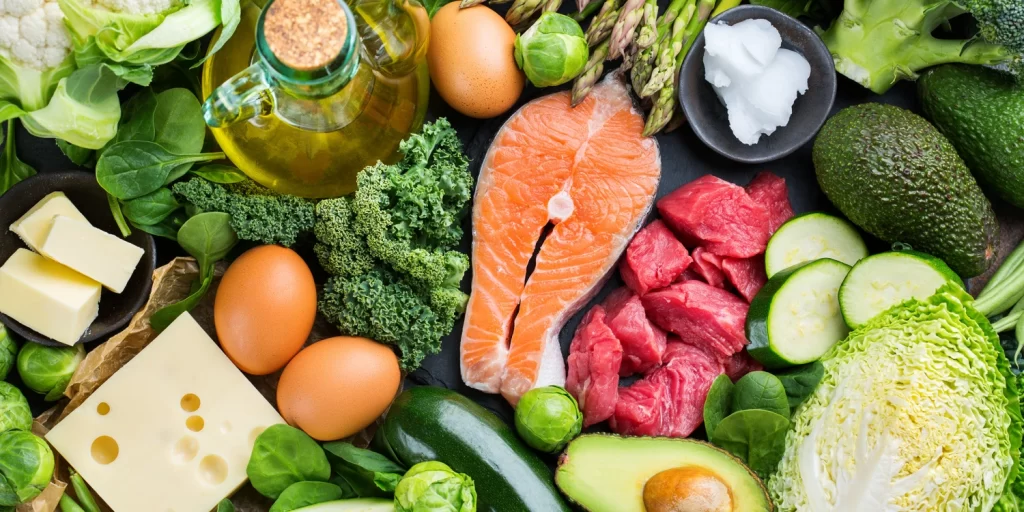Navigating the Ketogenic Diet – What You Need to Know

A ketogenic diet is a high-fat, adequate-protein and very-low-carbohydrate dietary therapy aimed at controlling difficult-to-control epilepsy in children. It omits sugary foods, but also fruits, beans and starchy vegetables such as potatoes.
Diets that stress fat-rich foods such as grass-fed ghee (butter), coconut oil, olive oil, avocados, hard-boiled eggs and nuts provide the body with these essential nutrients.
What is the Ketogenic Diet?
A ketogenic diet is one high in dietary fat and moderate in protein, and low in carbs, all of which can induce nutritional ketosis – fasting, or starvation, or a time of carbohydrate restriction – and leaves you in a place where you hope your body won’t have to shift into all those unhealthy systems that manifest with diabetes.
the carbohydrate intake is restricted to 50g per day or less on the Standard Ketogenic Diet* (SKD). There is no place for bread, pasta, rice cereal or other carbohydrate-rich conventional baked goods in this plan. Eggs, butter, cheese, meat, fish, seeds, nuts, leafy vegetables, and even fruit make up this plan.
Another benefit of switching to the keto diet is the rapid and sustained weight loss. For many, keto reduces appetite or increases satiety or both. You can expect a period of mild dehydration for the first three or four days as your body adjusts to low carb. if this continues, up your water and salt intake. Changing mineral balance (something you will be paying close attention to anyway) can also cause headaches, bad breath, fatigue, etc. These are merely symptoms of a side effect from the diet, all of which can be corrected by changing your nutrition.
How to Get Started
In case you haven’t heard of the keto diet, it’s a high-fat, low-carb eating plan, frequently used to treat childhood epilepsy and for other health benefits. By forcing your body to burn fat instead of carbs for energy – and producing compounds called ketone bodies that inhibit seizures.
You will need to make drastic changes, not only to your meals but also to your overall lifestyle habits – and switching can be uncomfortable (cutting out carbs can bring on headaches and bloating, for example). During this transition to a new diet, I highly recommend consulting with an accredited dietitian before following the meal plan outlined below. Breakfast: Baked eggs, avocado and sides Made from two uncooked eggs, this dish is a favourite for those who enjoy having their eggs served over medium, as you can cook it to perfection in just 10 minutes. It combines avocado with tomatoes, bell peppers and onions for added taste. The result is a rewarding, filling and easy meal that will prepare you for a busy day ahead. Serves one, according to Godfather’s Cookbook. Ingredients For the egg mixture: 2 eggs (uncooked) ▢1 tbsp paprika onion powder ▢1 tsp dill flakes ▢1⁄2 tsp tumeric ▢Salt and pepper (to taste) For the main dish: ▢½ avocado half sliced, half chopped ▢½ tomato, cut into cubes or rings ▢½ bell pepper, chopped 1-2 slices onion Ingredients for optional sides: ▢½ hot dog, cooked Salad, cooked tomato sauce, sausage, bacon (optional). Instructions Preheat the oven to 180 C/375 F. You can either prepare the meal in advance or cook while baking the eggs. Prepare the egg mixture (see recipe below). In a medium-sized, round pan, add the tomato, onion, peppers, and avocado bits, then pour in the egg mixture. Toni Katany is an environmental lawyer, economist and public speaker.
First, learning to read food labels for keto-appropriate products. Knowing how many grams of carb, protein and fat are in a serving will guide smart choices; keeping costs manageable means focusing on in-season organic produce that one shops for versus packaged goods that seldom pack up well and will then spoil.
Meal Planning
The keto diet focuses on discontinuing the consumption of carbohydrates and replacing them with the fats of fish, poultry, eggs and dairy products, alongside fresh and dried fruits not used for sweetening, low-carb vegetables, and liquids without added sweeteners or sugar.
The ketogenic diet is successful in treating paediatric epilepsy and might be most useful in other diseases marked by increased glucose levels, including Alzheimer’s and Parkinson’s. Because the ketogenic diet is such a drastic shift, it is a good idea to first consult with a healthcare provider to find out if the diet is appropriate for you.
A registered dietician can help you formulate a ketogenic meal plan based on your current health conditions and develop a macro-tracking plan in an app specifically for keto diet. She may even provide you with tasty ketogenic recipes, such as this one (which contains moderate carbs) by our staff nutritionist and blogger, Kelly Kennedy of Everyday Health.
Supplements
The ketogenic diet restricts daily carb intake to fewer than 50 grams; and thus, off-limits are breads, grains, cereals, fruits and many legumes, as are starchy vegetables such as legumes. Even dairy products, and fatty meat products, like bacon ham and butter can be forbidden. While making the effort easier to get appropriate nutrients, the restrictive diet can give rise to unpleasant symptoms such as fatigue, headache and nausea, which for many individuals make the eating pattern unbearable in the long term.
For those on a ketogenic diet, supplementation can reduce adverse effects and improve outcomes. Dieters must take more special care to be sure they consume enough dietary fibre, Vitamin D and potassium, with special attention given to those deficient in one or more of these. Individuals following such a diet might also want to consider a test for Vitamin-D deficiency, while greatly increasing daily intake of fermented foods, rich in short-chain fatty acids, to support gut function.
Keto-friendly supplements you may want to try include creatine monohydrate (an organic acid found within your body that can enhance exercise capacity), omega-3 fatty acids (healthy longer-chain fats), and medium-chain triglycerides (also known as MCTs, a type of fat). These nutrients can help support exercise capacity and muscle-building. But before you consider taking any supplement, you should talk to a registered dietitian nutritionist first.








